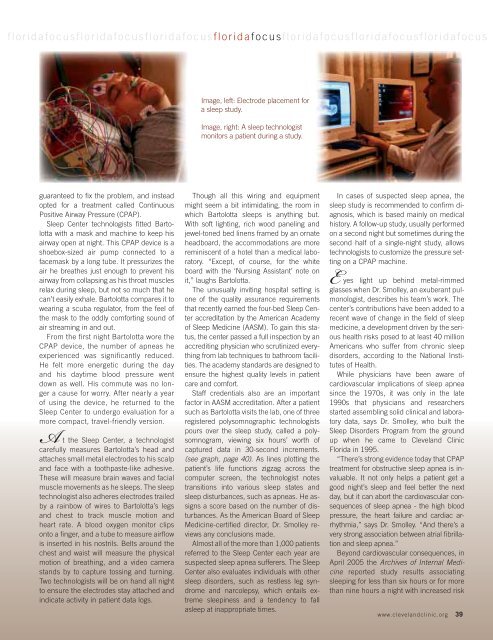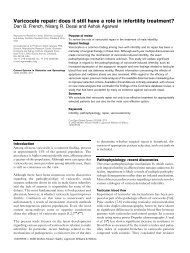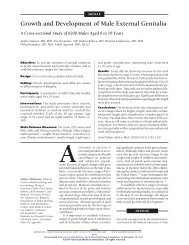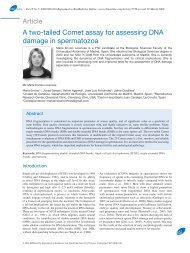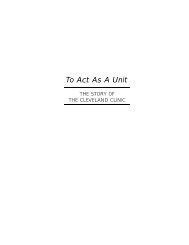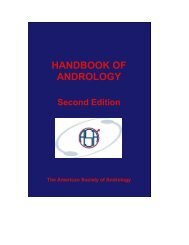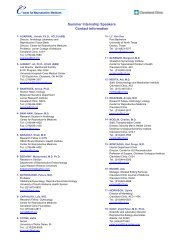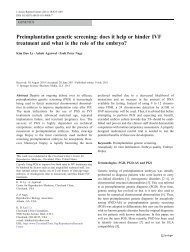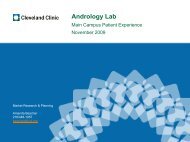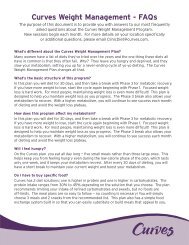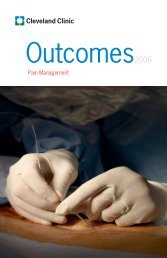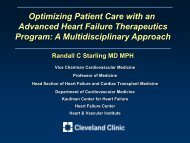clevelandclinicmagazine - Best Hospitals, US News best hospitals
clevelandclinicmagazine - Best Hospitals, US News best hospitals
clevelandclinicmagazine - Best Hospitals, US News best hospitals
- No tags were found...
Create successful ePaper yourself
Turn your PDF publications into a flip-book with our unique Google optimized e-Paper software.
floridafocusfloridafocusfloridafocusfloridafocusfloridafocusfloridafocusfloridafocusImage, left: Electrode placement fora sleep study.Image, right: A sleep technologistmonitors a patient during a study.guaranteed to fi x the problem, and insteadopted for a treatment called ContinuousPositive Airway Pressure (CPAP).Sleep Center technologists fi tted Bartolottawith a mask and machine to keep hisairway open at night. This CPAP device is ashoebox-sized air pump connected to afacemask by a long tube. It pressurizes theair he breathes just enough to prevent hisairway from collapsing as his throat musclesrelax during sleep, but not so much that hecan’t easily exhale. Bartolotta compares it towearing a scuba regulator, from the feel ofthe mask to the oddly comforting sound ofair streaming in and out.From the first night Bartolotta wore theCPAP device, the number of apneas heexperienced was significantly reduced.He felt more energetic during the dayand his daytime blood pressure wentdown as well. His commute was no longera cause for worry. After nearly a yearof using the device, he returned to theSleep Center to undergo evaluation for amore Acompact, travel-friendly version.t the Sleep Center, a technologistcarefully measures Bartolotta’s head andattaches small metal electrodes to his scalpand face with a toothpaste-like adhesive.These will measure brain waves and facialmuscle movements as he sleeps. The sleeptechnologist also adheres electrodes trailedby a rainbow of wires to Bartolotta’s legsand chest to track muscle motion andheart rate. A blood oxygen monitor clipsonto a fi nger, and a tube to measure airfl owis inserted in his nostrils. Belts around thechest and waist will measure the physicalmotion of breathing, and a video camerastands by to capture tossing and turning.Two technologists will be on hand all nightto ensure the electrodes stay attached andindicate activity in patient data logs.Though all this wiring and equipmentmight seem a bit intimidating, the room inwhich Bartolotta sleeps is anything but.With soft lighting, rich wood paneling andjewel-toned bed linens framed by an ornateheadboard, the accommodations are morereminiscent of a hotel than a medical laboratory.“Except, of course, for the whiteboard with the ‘Nursing Assistant’ note onit,” laughs Bartolotta.The unusually inviting hospital setting isone of the quality assurance requirementsthat recently earned the four-bed Sleep Centeraccreditation by the American Academyof Sleep Medicine (AASM). To gain this status,the center passed a full inspection by anaccrediting physician who scrutinized everythingfrom lab techniques to bathroom facilities.The academy standards are designed toensure the highest quality levels in patientcare and comfort.Staff credentials also are an importantfactor in AASM accreditation. After a patientsuch as Bartolotta visits the lab, one of threeregistered polysomnographic technologistspours over the sleep study, called a polysomnogram,viewing six hours’ worth ofcaptured data in 30-second increments.(see graph, page 40). As lines plotting thepatient’s life functions zigzag across thecomputer screen, the technologist notestransitions into various sleep states andsleep disturbances, such as apneas. He assignsa score based on the number of disturbances.As the American Board of SleepMedicine-certifi ed director, Dr. Smolley reviewsany conclusions made.Almost all of the more than 1,000 patientsreferred to the Sleep Center each year aresuspected sleep apnea sufferers. The SleepCenter also evaluates individuals with othersleep disorders, such as restless leg syndromeand narcolepsy, which entails extremesleepiness and a tendency to fallasleep at inappropriate times.In cases of suspected sleep apnea, thesleep study is recommended to confi rm diagnosis,which is based mainly on medicalhistory. A follow-up study, usually performedon a second night but sometimes during thesecond half of a single-night study, allowstechnologists to customize the pressure settingEon a CPAP machine.yes light up behind metal-rimmedglasses when Dr. Smolley, an exuberant pulmonologist,describes his team’s work. Thecenter’s contributions have been added to arecent wave of change in the fi eld of sleepmedicine, a development driven by the serioushealth risks posed to at least 40 millionAmericans who suffer from chronic sleepdisorders, according to the National Institutesof Health.While physicians have been aware ofcardiovascular implications of sleep apneasince the 1970s, it was only in the late1990s that physicians and researchersstarted assembling solid clinical and laboratorydata, says Dr. Smolley, who built theSleep Disorders Program from the groundup when he came to Cleveland ClinicFlorida in 1995.“There’s strong evidence today that CPAPtreatment for obstructive sleep apnea is invaluable.It not only helps a patient get agood night’s sleep and feel better the nextday, but it can abort the cardiovascular consequencesof sleep apnea - the high bloodpressure, the heart failure and cardiac arrhythmia,”says Dr. Smolley. “And there’s avery strong association between atrial fibrillationand sleep apnea.”Beyond cardiovascular consequences, inApril 2005 the Archives of Internal Medicinereported study results associatingsleeping for less than six hours or for morethan nine hours a night with increased riskwww.clevelandclinic.org 39


